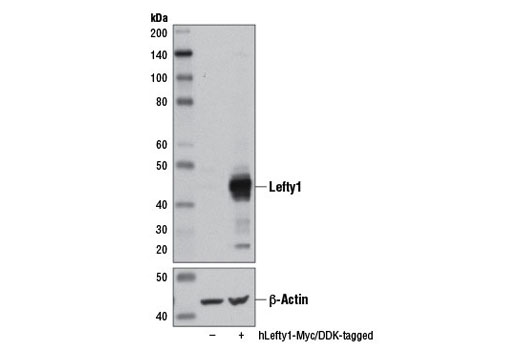WB
H
Transfected Only
40
Rabbit IgG
#O75610
10637
Product Information
Product Usage Information
| Application | Dilution |
|---|---|
| Western Blotting | 1:1000 |
Storage
Specificity / Sensitivity
Species Reactivity:
Human
Species predicted to react based on 100% sequence homology
The antigen sequence used to produce this antibody shares
100% sequence homology with the species listed here, but
reactivity has not been tested or confirmed to work by CST.
Use of this product with these species is not covered under
our
Product Performance Guarantee.
Mouse, Rat, Monkey
Source / Purification
Monoclonal antibody is produced by immunizing animals with a synthetic peptide corresponding to residues surrounding Pro108 of human lefty1 protein.
Background
Lefty proteins are members of the TGF-β family of cell signaling molecules that are involved in growth and development (1,2). Named for their role in left-right axis determination and their exclusive expression on the left side of the developing mouse embryo, lefty1 and lefty2 contain a cysteine-knot motif that is characteristic of TGF-β related proteins, but lack an alpha-helix and a cysteine residue critical for ligand dimerization (3). Early in vertebrate embryogenesis, lefty represses TGF-β signaling by inhibiting the phosphorylation of Smad2 following activation of the TGF-β receptor (4). Down-regulated very early upon differentiation (5), lefty proteins act as extracellular antagonists of the signaling pathway for Nodal, a TGF-β ligand critical for left-right patterning and formation of the mesoderm and endoderm (6). Similar to other members of the TGF-β superfamily, lefty proproteins undergo cleavage to release a bioactive protein (7). The biologically active 42 kDa lefty precursor and the 28 kDa polypeptide have been shown to induce MAPK activity (7).
- Kingsley, D.M. (1994) Genes Dev 8, 133-46.
- Heldin, C.H. et al. (1997) Nature 390, 465-71.
- Meno, C. et al. (1997) Genes Cells 2, 513-24.
- Ulloa, L. and Tabibzadeh, S. (2001) J Biol Chem 276, 21397-404.
- Besser, D. (2004) J Biol Chem 279, 45076-84.
- Schier, A.F. (2003) Annu Rev Cell Dev Biol 19, 589-621.
- Ulloa, L. et al. (2001) J Biol Chem 276, 21387-96.
Species Reactivity
Species reactivity is determined by testing in at least one approved application (e.g., western blot).
Western Blot Buffer
IMPORTANT: For western blots, incubate membrane with diluted primary antibody in 5% w/v BSA, 1X TBS, 0.1% Tween® 20 at 4°C with gentle shaking, overnight.
Applications Key
WB: Western Blotting
Cross-Reactivity Key
H: human M: mouse R: rat Hm: hamster Mk: monkey Vir: virus Mi: mink C: chicken Dm: D. melanogaster X: Xenopus Z: zebrafish B: bovine Dg: dog Pg: pig Sc: S. cerevisiae Ce: C. elegans Hr: horse GP: Guinea Pig Rab: rabbit All: all species expected
Trademarks and Patents
Limited Uses
Except as otherwise expressly agreed in a writing signed by a legally authorized representative of CST, the following terms apply to Products provided by CST, its affiliates or its distributors. Any Customer's terms and conditions that are in addition to, or different from, those contained herein, unless separately accepted in writing by a legally authorized representative of CST, are rejected and are of no force or effect.
Products are labeled with For Research Use Only or a similar labeling statement and have not been approved, cleared, or licensed by the FDA or other regulatory foreign or domestic entity, for any purpose. Customer shall not use any Product for any diagnostic or therapeutic purpose, or otherwise in any manner that conflicts with its labeling statement. Products sold or licensed by CST are provided for Customer as the end-user and solely for research and development uses. Any use of Product for diagnostic, prophylactic or therapeutic purposes, or any purchase of Product for resale (alone or as a component) or other commercial purpose, requires a separate license from CST. Customer shall (a) not sell, license, loan, donate or otherwise transfer or make available any Product to any third party, whether alone or in combination with other materials, or use the Products to manufacture any commercial products, (b) not copy, modify, reverse engineer, decompile, disassemble or otherwise attempt to discover the underlying structure or technology of the Products, or use the Products for the purpose of developing any products or services that would compete with CST products or services, (c) not alter or remove from the Products any trademarks, trade names, logos, patent or copyright notices or markings, (d) use the Products solely in accordance with CST Product Terms of Sale and any applicable documentation, and (e) comply with any license, terms of service or similar agreement with respect to any third party products or services used by Customer in connection with the Products.
